Reconstructing a Fine Resolution Landscape of Annual Gross Primary Product (1895–2013) with Tree-Ring Indices
Abstract
:1. Introduction
2. Methods
2.1. Study Areas
2.2. Date Source and Data Preprocessing
2.3. Pixel by Pixel Regression
2.4. Model Evaluation
2.5. Analysis of the Relationship between GPP and Climate Factors
3. Results
3.1. Model Performance
3.2. GPP Tendency in Our Study Areas
3.3. GPP and Climate
4. Discussion
4.1. Choosing the Best Models
4.2. Analyzing GPP Variation over a Century
4.3. The Relationship between GPP and Climate over a Century
4.4. Limitations and Future Research
5. Conclusions
Author Contributions
Funding
Data Availability Statement
Acknowledgments
Conflicts of Interest
Appendix A
| Adjust R2 | RMSE | MAPE | MAE | |||
|---|---|---|---|---|---|---|
| 1895 | Fold 1 | RF_1990 | 0.139 | 779.987 | 0.222 | 540.724 |
| GRNN_1990 | 0.057 | 862.972 | 0.245 | 592.908 | ||
| SVM_1990 | 0.267 | 696.191 | 0.199 | 490.286 | ||
| Fold 2 | RF_1995 | 0.731 | 319.574 | 0.085 | 242.784 | |
| GRNN_1995 | 0.759 | 351.308 | 0.099 | 282.886 | ||
| SVM_1995 | 0.454 | 1312.242 | 0.331 | 1018.100 | ||
| Fold 3 | RF_2000 | 0.622 | 653.610 | 0.150 | 564.771 | |
| GRNN_2000 | 0.628 | 646.874 | 0.148 | 558.365 | ||
| SVM_2000 | 0.266 | 907.202 | 0.202 | 763.053 | ||
| Fold 4 | RF_2005 | 0.301 | 726.716 | 0.162 | 567.789 | |
| GRNN_2005 | 0.599 | 491.448 | 0.106 | 372.735 | ||
| SVM_2005 | 0.001 | 1515.378 | 0.354 | 1230.154 | ||
| Fold 5 | RF_2010 | 0.601 | 425.005 | 0.091 | 309.606 | |
| GRNN_2010 | 0.619 | 444.631 | 0.097 | 335.374 | ||
| SVM_2010 | 0.194 | 1584.388 | 0.358 | 1222.076 | ||
| Average | RF | 0.479 | 580.978 | 0.142 | 445.135 | |
| GRNN | 0.532 | 559.447 | 0.139 | 428.454 | ||
| SVM | 0.236 | 1203.080 | 0.289 | 944.734 | ||
| 1938 | Fold 1 | RF_1990 | 0.202 | 763.054 | 0.218 | 530.606 |
| GRNN_1990 | 0.071 | 853.562 | 0.242 | 584.347 | ||
| SVM_1990 | 0.920 | 227.233 | 0.056 | 164.110 | ||
| Fold 2 | RF_1995 | 0.786 | 474.795 | 0.141 | 411.942 | |
| GRNN_1995 | 0.755 | 365.801 | 0.104 | 296.900 | ||
| SVM_1995 | 0.677 | 579.609 | 0.158 | 479.357 | ||
| Fold 3 | RF_2000 | 0.668 | 569.506 | 0.129 | 483.791 | |
| GRNN_2000 | 0.662 | 603.192 | 0.137 | 517.190 | ||
| SVM_2000 | 0.682 | 628.358 | 0.147 | 540.424 | ||
| Fold 4 | RF_2005 | 0.777 | 370.025 | 0.078 | 275.672 | |
| GRNN_2005 | 0.623 | 464.811 | 0.100 | 349.872 | ||
| SVM_2005 | 0.659 | 566.820 | 0.135 | 473.535 | ||
| Fold 5 | RF_2010 | 0.689 | 423.658 | 0.092 | 321.172 | |
| GRNN_2010 | 0.651 | 417.758 | 0.091 | 311.620 | ||
| SVM_2010 | 0.521 | 899.115 | 0.194 | 651.968 | ||
| Average | RF | 0.625 | 520.208 | 0.132 | 404.637 | |
| GRNN | 0.552 | 541.025 | 0.135 | 411.986 | ||
| SVM | 0.692 | 580.227 | 0.138 | 461.879 |
| Precipitation | PreMay | PreJun | PreJul | PreAug | PreSep | PreOct | PreNov | PreDec | |
|---|---|---|---|---|---|---|---|---|---|
| Real Forest | 0.022 | 0.043 | −0.161 | 0.291 | 0.157 | −0.051 | −0.373 | −0.293 | |
| Real Grass | 0.111 | 0.205 | −0.322 | 0.260 | 0.161 | −0.012 | −0.362 | −0.229 | |
| Real+ Simulated Forest | −0.053 | 0.039 | −0.068 | 0.280 | 0.058 | −0.037 | −0.145 | −0.051 | |
| Real+ Simulated Grass | −0.014 | 0.122 | −0.110 | 0.243 | 0.054 | −0.022 | −0.191 | −0.008 | |
| Precipitation | January | February | March | April | May | June | July | August | September |
| Real Forest | 0.005 | 0.155 | −0.082 | 0.073 | 0.379 | 0.511 | 0.199 | −0.113 | −0.110 |
| Real Grass | 0.223 | 0.147 | −0.132 | 0.138 | 0.371 | 0.592 | −0.063 | −0.046 | −0.129 |
| Real+ Simulated Forest | 0.101 | 0.138 | 0.055 | −0.061 | 0.197 | 0.483 | 0.271 | −0.107 | −0.114 |
| Real+ Simulated Grass | 0.184 | 0.128 | 0.040 | −0.040 | 0.182 | 0.516 | 0.162 | −0.084 | −0.125 |
| Temperature | PreMay | PreJun | PreJul | PreAug | PreSep | PreOct | PreNov | PreDec | |
|---|---|---|---|---|---|---|---|---|---|
| Real Forest | −0.057 | −0.204 | −0.317 | 0.007 | 0.216 | 0.273 | −0.333 | −0.266 | |
| Real Grass | 0.042 | −0.187 | −0.197 | −0.003 | 0.224 | 0.314 | −0.109 | −0.089 | |
| Real+ Simulated Forest | 0.107 | −0.068 | −0.163 | −0.023 | 0.100 | 0.100 | −0.101 | −0.094 | |
| Real+ Simulated Grass | 0.168 | −0.050 | −0.108 | −0.042 | 0.087 | 0.089 | −0.011 | 0.002 | |
| Temperature | January | February | March | April | May | June | July | August | September |
| Real Forest | −0.106 | 0.029 | −0.537 | −0.038 | −0.330 | −0.190 | −0.623 | −0.244 | 0.134 |
| Real Grass | −0.168 | −0.037 | −0.398 | 0.129 | −0.168 | −0.120 | −0.467 | −0.056 | 0.176 |
| Real+ Simulated Forest | −0.047 | 0.020 | −0.130 | −0.041 | −0.178 | −0.287 | −0.317 | −0.180 | −0.028 |
| Real+ Simulated Grass | −0.070 | −0.006 | −0.098 | 0.003 | −0.103 | −0.241 | −0.233 | −0.095 | −0.026 |
| PDSI | PreMay | PreJun | PreJul | PreAug | PreSep | PreOct | PreNov | PreDec | |
|---|---|---|---|---|---|---|---|---|---|
| Real Forest | −0.090 | −0.030 | −0.073 | 0.008 | 0.051 | −0.009 | −0.099 | −0.133 | |
| Real Grass | −0.050 | 0.136 | 0.037 | 0.155 | 0.191 | 0.113 | −0.012 | −0.069 | |
| Real + Simulated Forest | −0.101 | −0.086 | −0.074 | 0.023 | 0.043 | 0.022 | −0.032 | −0.022 | |
| Real + Simulated Grass | −0.075 | −0.019 | −0.023 | 0.080 | 0.095 | 0.072 | −0.008 | −0.002 | |
| PDSI | January | February | March | April | May | June | July | August | September |
| Real Forest | −0.125 | −0.139 | −0.124 | −0.111 | 0.171 | 0.453 | 0.617 | 0.696 | 0.613 |
| Real Grass | −0.042 | −0.023 | −0.030 | −0.023 | 0.169 | 0.499 | 0.540 | 0.694 | 0.590 |
| Real + Simulated Forest | 0.004 | 0.030 | 0.057 | 0.033 | 0.127 | 0.304 | 0.415 | 0.442 | 0.399 |
| Real + Simulated Grass | 0.040 | 0.071 | 0.088 | 0.060 | 0.124 | 0.307 | 0.380 | 0.426 | 0.375 |

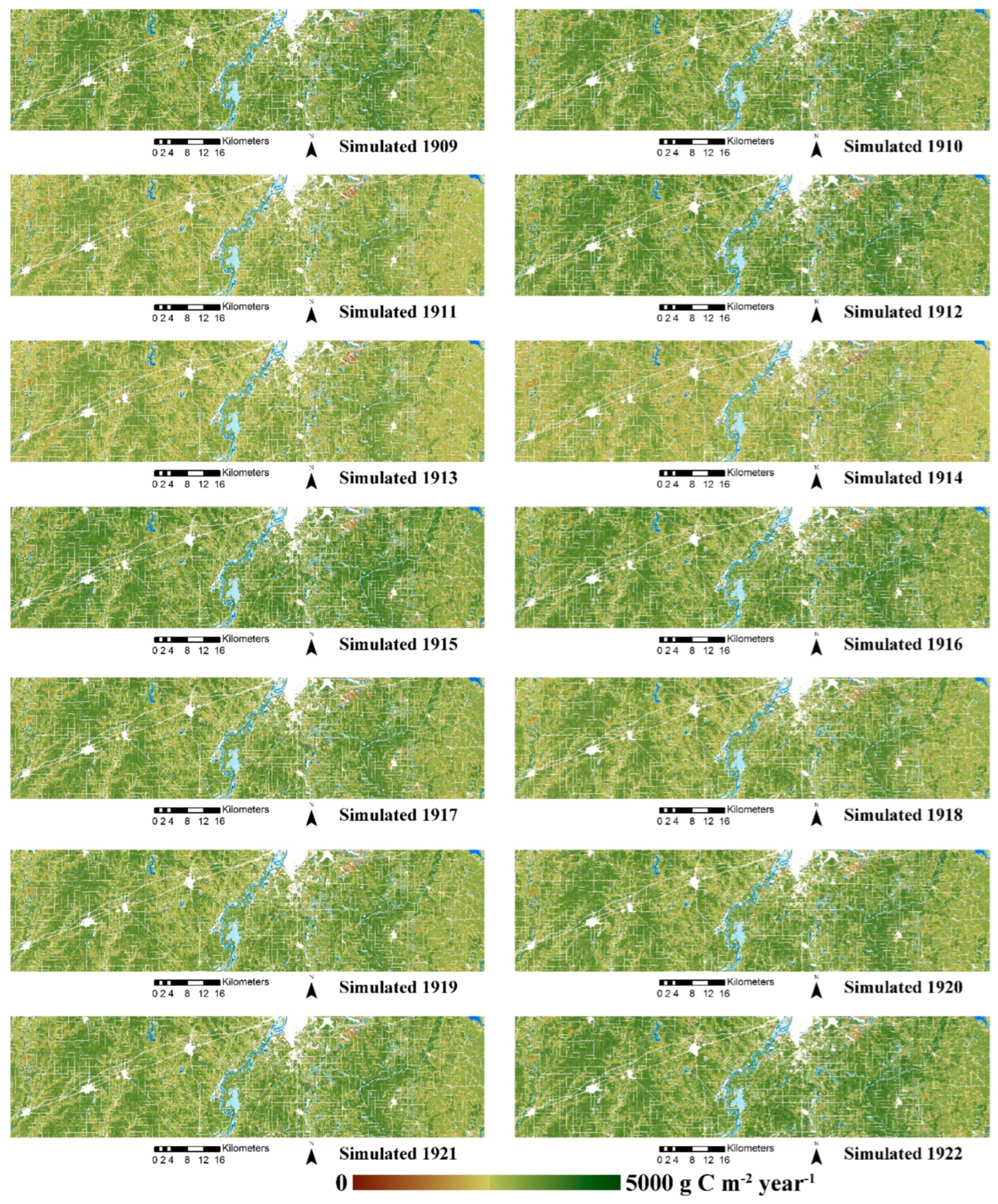
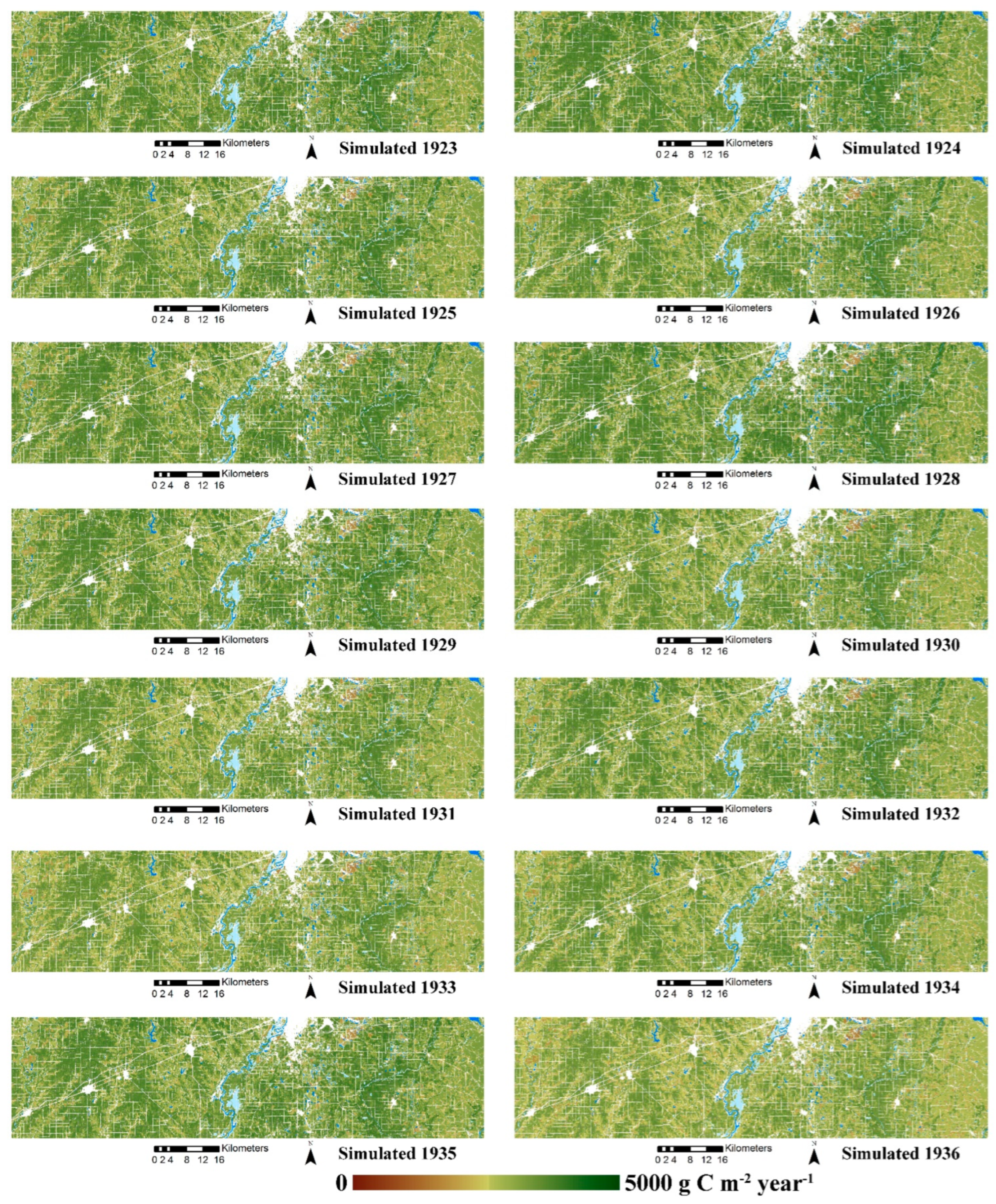

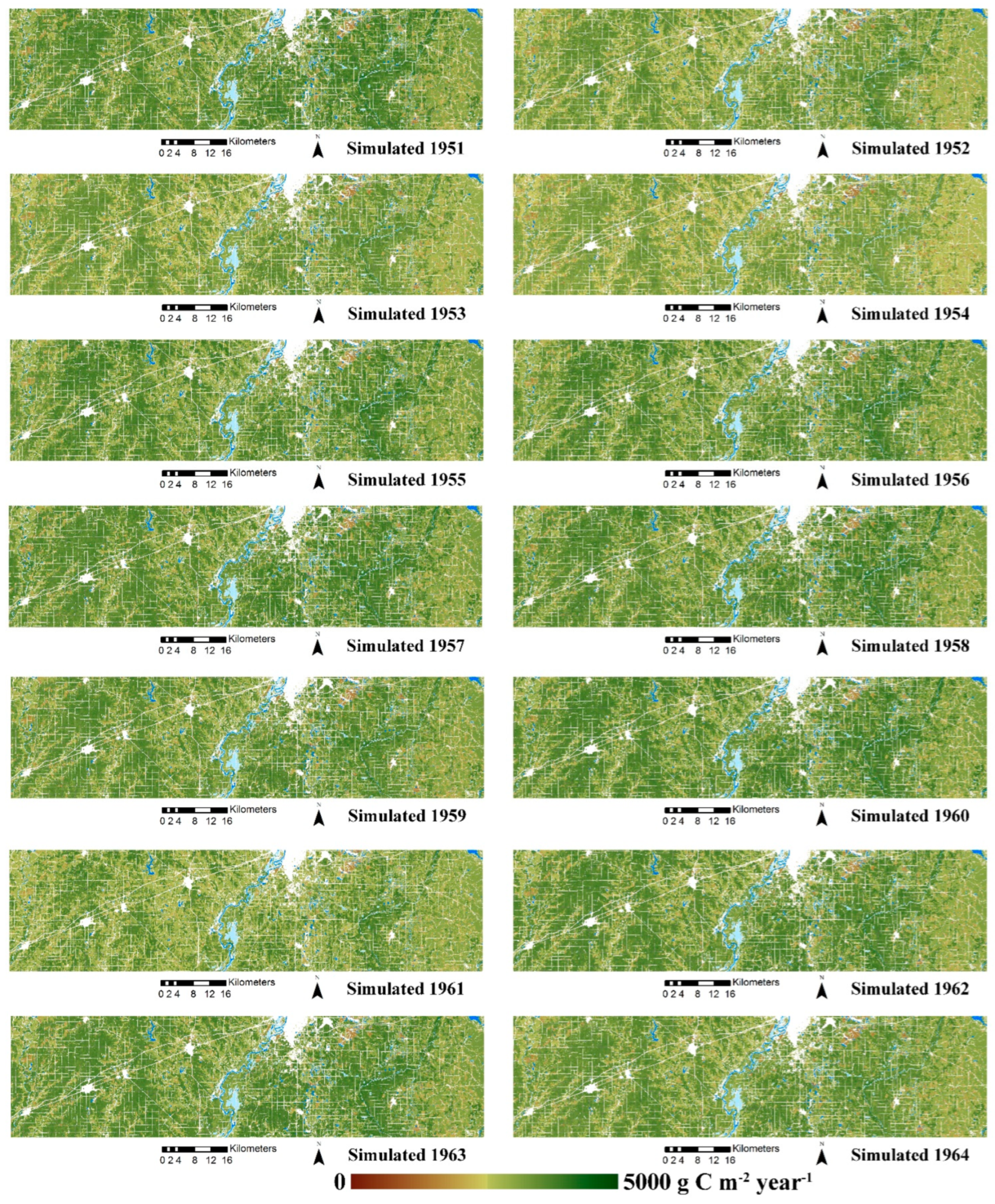



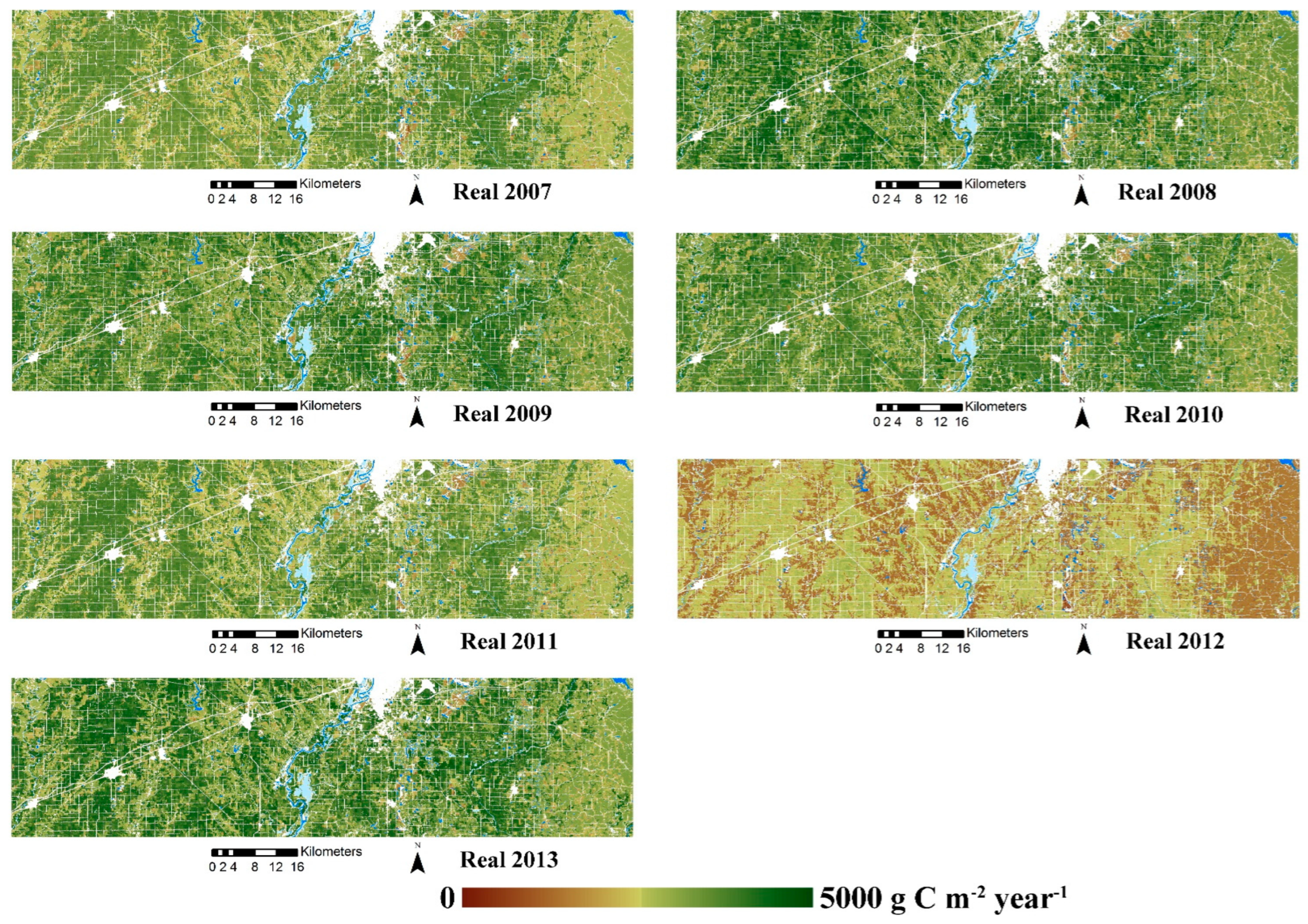
References
- Paik, S.; Min, S.K.; Zhang, X.; Donat, M.G.; King, A.D.; Sun, Q. Determining the anthropogenic greenhouse gas contribution to the observed intensification of extreme precipitation. Geophys. Res. Lett. 2020, 47, e2019GL086875. [Google Scholar] [CrossRef]
- Seong, M.G.; Min, S.K.; Kim, Y.H.; Zhang, X.; Sun, Y. Anthropogenic greenhouse gas and aerosol contributions to extreme temperature changes during 1951–2015. J. Clim. 2021, 34, 857–870. [Google Scholar] [CrossRef]
- Bai, X.; Zhang, S.; Li, C.; Xiong, L.; Song, F.; Du, C.; Li, M.; Luo, Q.; Xue, Y.; Wang, S. A carbon-neutrality-capacity index for evaluating carbon sink contributions. Environ. Sci. Ecotechnol. 2023, 15, 100237. [Google Scholar] [CrossRef]
- Lamarque, J.F.; Bond, T.C.; Eyring, V.; Granier, C.; Heil, A.; Klimont, Z.; Lee, D.; Liousse, C.; Mieville, A.; Owen, B.; et al. Historical (1850–2000) gridded anthropogenic and biomass burning emissions of reactive gases and aerosols: Methodology and application. Atmos. Chem. Phys. 2010, 10, 7017–7039. [Google Scholar] [CrossRef]
- Henriques, S.; Borowiecki, K. The drivers of long-run CO2 emissions: A global perspective since 1800. Discuss. Pap. Bus. Econ. Univ. South. Den. 2014, 13, 1–45. [Google Scholar] [CrossRef]
- Hou, Y.; Wang, S.; Zhou, Y.; Yan, F.; Zhu, J. Analysis of the carbon dioxide concentration in the lowest atmospheric layers and the factors affecting China based on satellite observations. Int. J. Remote Sens. 2013, 34, 1981–1994. [Google Scholar] [CrossRef]
- Sun, Z.; Wang, X.; Zhang, X.; Tani, H.; Guo, E.; Yin, S.; Zhang, T. Evaluating and comparing remote sensing terrestrial GPP models for their response to climate variability and CO2 trends. Sci. Total Environ. 2019, 668, 696–713. [Google Scholar] [CrossRef]
- Markham, B.L.; Helder, D.L. Forty-year calibrated record of earth-reflected radiance from Landsat: A review. Remote Sens. Environ. 2012, 122, 30–40. [Google Scholar] [CrossRef]
- Alam, S.A.; Huang, J.G.; Stadt, K.J.; Comeau, P.G.; Dawson, A.; Gea-Izquierdo, G.; Aakala, T.; Hölttä, T.; Vesala, T.; Mäkelä, A.; et al. Effects of competition, drought stress and photosynthetic productivity on the radial growth of white spruce in western Canada. Front. Plant Sci. 2017, 8, 1915. [Google Scholar] [CrossRef]
- Decuyper, M.; Chávez, R.O.; Čufar, K.; Estay, S.A.; Clevers, J.G.; Prislan, P.; Gričar, J.; Črepinšek, Z.; Merela, M.; Luis, M.D.; et al. Spatio-temporal assessment of beech growth in relation to climate extremes in Slovenia–An integrated approach using remote sensing and tree-ring data. Agric. For. Meteorol. 2020, 287, 107925. [Google Scholar] [CrossRef]
- Zhou, Y.; Yi, Y.; Jia, W.; Cai, Y.; Yang, W.; Li, Z. Applying dendrochronology and remote sensing to explore climate-drive in montane forests over space and time. Quat. Sci. Rev. 2020, 237, 106292. [Google Scholar] [CrossRef]
- Wang, T.; Bao, A.; Xu, W.; Zheng, G.; Nzabarinda, V.; Yu, T.; Huang, X.; Long, G.; Naibi, S. Dynamics of forest net primary productivity based on tree ring reconstruction in the Tianshan Mountains. Ecol. Indic. 2023, 146, 109713. [Google Scholar] [CrossRef]
- Liang, E.; Shao, X.; Liu, H.; Eckstein, D. Tree-ring based PDSI reconstruction since AD 1842 in the Ortindag Sand Land, east Inner Mongolia. Chin. Sci. Bull. 2007, 52, 2715–2721. [Google Scholar] [CrossRef]
- Li, H.; Thapa, I.; Speer, J.H. Fine-scale ndvi reconstruction back to 1906 from tree-rings in the greater yellowstone ecosystem. Forests 2021, 12, 1324. [Google Scholar] [CrossRef]
- Homer, C.; Dewitz, J.; Jin, S.; Xian, G.; Costello, C.; Danielson, P.; Gass, L.; Funk, M.; Wickham, J.; Stehman, S.; et al. Conterminous United States land cover change patterns 2001–2016 from the 2016 national land cover database. ISPRS J. Photogramm. Remote Sens. 2020, 162, 184–199. [Google Scholar] [CrossRef] [PubMed]
- Speer, J.H. Fundamentals of Tree-Ring Research; University of Arizona Press: Tucson, AZ, USA, 2010. [Google Scholar]
- Maxwell, R.S.; Larsson, L.A. Measuring tree-ring widths using the CooRecorder software application. Dendrochronologia 2021, 67, 125841. [Google Scholar] [CrossRef]
- Cook, E.R. A Time Series Analysis Approach to Tree Ring Standardization (Dendrochronology, Forestry, Dendroclimatology, Autoregressive Process); The University of Arizona: Tucson, AZ, USA, 1985. [Google Scholar]
- Wigley, T.M.; Briffa, K.R.; Jones, P.D. On the average value of correlated time series, with applications in dendroclimatology and hydrometeorology. J. Appl. Meteorol. Climatol. 1984, 23, 201–213. [Google Scholar] [CrossRef]
- Robinson, N.P.; Allred, B.W.; Smith, W.K.; Jones, M.O.; Moreno, A.; Erickson, T.A.; Naugle, D.E.; Running, S.W. Terrestrial primary production for the conterminous United States derived from Landsat 30 m and MODIS 250 m. Remote Sens. Ecol. Conserv. 2018, 4, 264–280. [Google Scholar] [CrossRef]
- Liu, Y.; Lei, H. Responses of natural vegetation dynamics to climate drivers in China from 1982 to 2011. Remote Sens. 2015, 7, 10243–10268. [Google Scholar] [CrossRef]
- Stahle, D.W.; Fye, F.K.; Cook, E.R.; Griffin, R.D. Tree-ring reconstructed megadroughts over North America since AD 1300. Clim. Chang. 2007, 83, 133–149. [Google Scholar] [CrossRef]
- Belgiu, M.; Drăguţ, L. Random forest in remote sensing: A review of applications and future directions. ISPRS J. Photogramm. Remote Sens. 2016, 114, 24–31. [Google Scholar] [CrossRef]
- Yang, Y.; Cao, C.; Pan, X.; Li, X.; Zhu, X. Downscaling land surface temperature in an arid area by using multiple remote sensing indices with random forest regression. Remote Sens. 2017, 9, 789. [Google Scholar] [CrossRef]
- Specht, D.F. A general regression neural network. IEEE Trans. Neural Netw. 1991, 2, 568–576. [Google Scholar] [CrossRef] [PubMed]
- Cui, Y.; Chen, X.; Xiong, W.; He, L.; Lv, F.; Fan, W.; Luo, Z.; Hong, Y. A soil moisture spatial and temporal resolution improving algorithm based on multi-source remote sensing data and GRNN model. Remote Sens. 2020, 12, 455. [Google Scholar] [CrossRef]
- Li, L.; Xu, T.; Chen, Y. Improved urban flooding mapping from remote sensing images using generalized regression neural network-based super-resolution algorithm. Remote Sens. 2016, 8, 625. [Google Scholar] [CrossRef]
- Zhang, Q.; Xiao, Y. An Unsupervised Method Based on Fire Index Enhancement and Grnn for Automated Burned Area Mapping from Single-Period Remote Sensing Imagery. ISPRS Ann. Photogramm. Remote Sens. Spat. Inf. Sci. 2021, 3, 37–42. [Google Scholar] [CrossRef]
- Nalepa, J.; Kawulok, M. Selecting training sets for support vector machines: A review. Artif. Intell. Rev. 2019, 52, 857–900. [Google Scholar] [CrossRef]
- Yuan, H.; Yang, G.; Li, C.; Wang, Y.; Liu, J.; Yu, H.; Feng, H.; Xu, B.; Zhao, X.; Yang, X. Retrieving soybean leaf area index from unmanned aerial vehicle hyperspectral remote sensing: Analysis of RF, ANN and SVM regression models. Remote Sens. 2017, 9, 309. [Google Scholar] [CrossRef]
- Xiao, X.; Zhang, T.; Zhong, X.; Shao, W.; Li, X. Support vector regression snow-depth retrieval algorithm using passive microwave remote sensing data. Remote Sens. Environ. 2018, 210, 48–64. [Google Scholar] [CrossRef]
- Tariq, A.; Jiango, Y.; Li, Q.; Gao, J.; Lu, L.; Soufan, W.; Almutairi, K.F.; Habib-ur-Rahman, M. Modelling, mapping and monitoring of forest cover changes, using support vector machine, kernel logistic regression and naive bayes tree models with optical remote sensing data. Heliyon 2023, 9, e13212. [Google Scholar] [CrossRef]
- Spiess, A.N.; Neumeyer, N. An evaluation of R2 as an inadequate measure for nonlinear models in pharmacological and biochemical research: A Monte Carlo approach. BMC Pharmacol. 2010, 10, 6. [Google Scholar] [CrossRef] [PubMed]
- Contosta, A.R.; Casson, N.J.; Garlick, S.; Nelson, S.J.; Ayres, M.P.; Burakowski, E.A.; Campbell, J.; Creed, I.; Eimers, C.; Evans, C.; et al. Northern forest winters have lost cold, snowy conditions that are important for ecosystems and human communities. Ecol. Appl. 2019, 29, e01974. [Google Scholar] [CrossRef] [PubMed]
- Joiner, J.; Yoshida, Y.; Zhang, Y.; Duveiller, G.; Jung, M.; Lyapustin, A.; Wang, Y.; Tucker, C.J. Estimation of terrestrial global gross primary production (GPP) with satellite data-driven models and eddy covariance flux data. Remote Sens. 2018, 10, 1346. [Google Scholar] [CrossRef]
- Walker, L.R.; Wardle, D.A.; Bardgett, R.D.; Clarkson, B.D. The use of chronosequences in studies of ecological succession and soil development. J. Ecol. 2010, 98, 725–736. [Google Scholar] [CrossRef]
- Buma, B.; Bisbing, S.M.; Wiles, G.; Bidlack, A.L. 100 yr of primary succession highlights stochasticity and competition driving community establishment and stability. Ecology 2019, 100, e02885. [Google Scholar] [CrossRef]
- Maxwell, J.T.; Harley, G.L. Increased tree-ring network density reveals more precise estimations of sub-regional hydroclimate variability and climate dynamics in the Midwest. USA Clim. Dyn. 2017, 49, 1479–1493. [Google Scholar] [CrossRef]


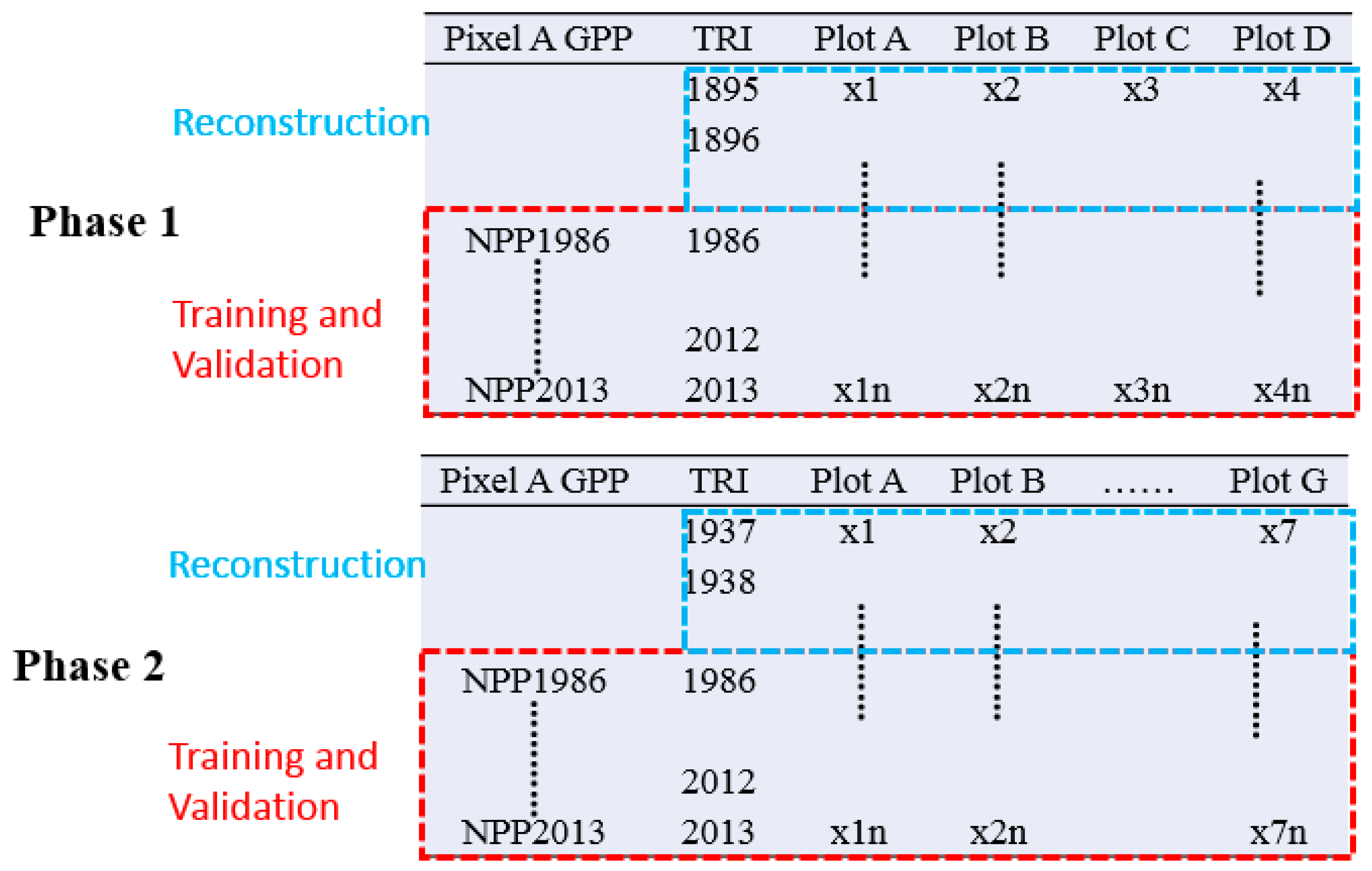


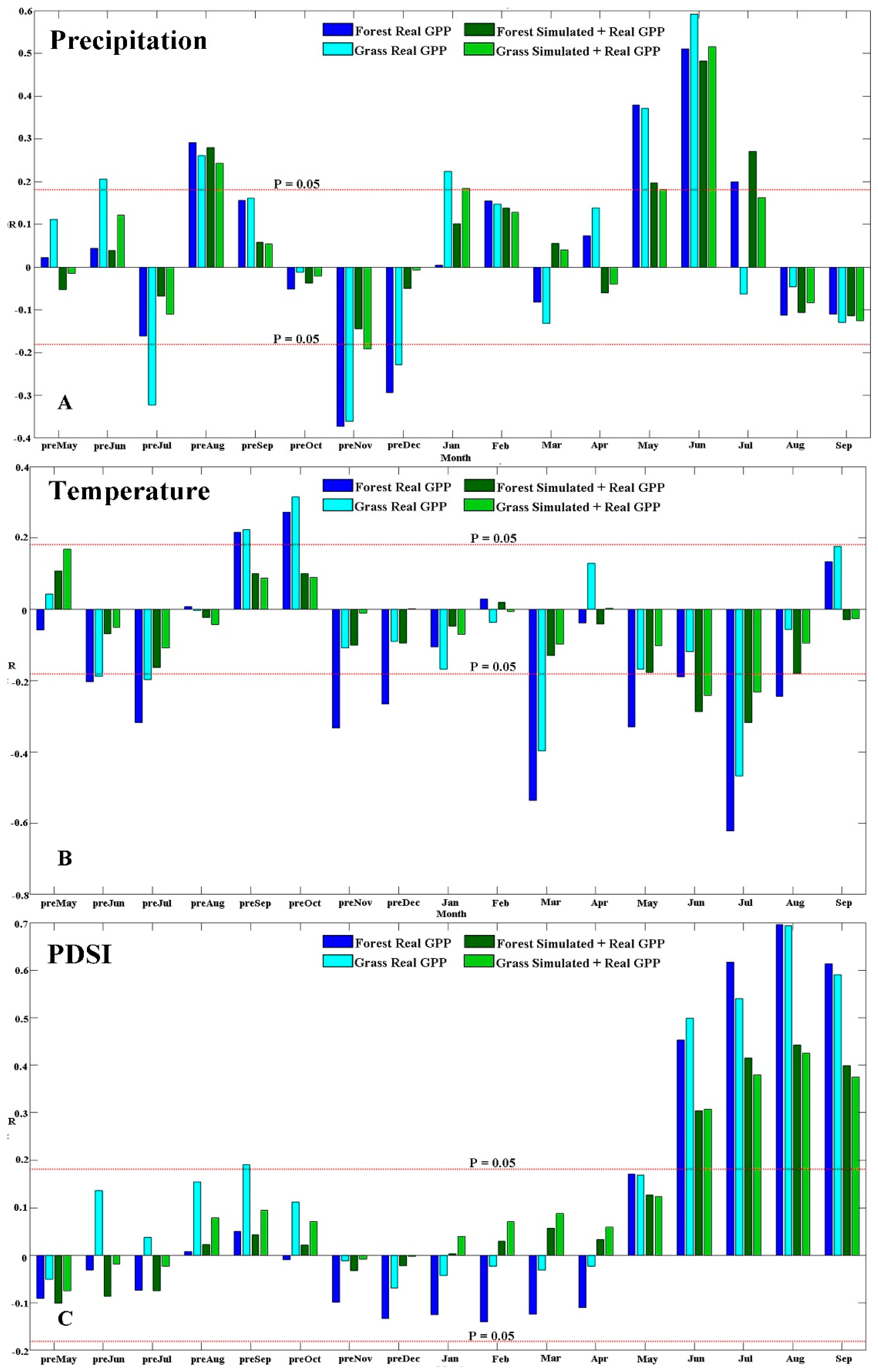
| Order | ITRDB ID | Species Name | Scientifc Name | Earliest Year | Latest Year | Available Phases |
|---|---|---|---|---|---|---|
| 1 | IL018 | White Oak | Quercus alba | 1847 | 2014 | Phase 1 and Phase 2 |
| 2 | IL030 | Sugar Maple | Acer saccharum | 1895 | 2016 | Phase 1 and Phase 2 |
| 3 | IN012 | Shagbark Hickory | Carya ovata | 1912 | 2013 | Phase 2 |
| 4 | IN013 | Tuliptree | Liriodendron tulipifera | 1920 | 2013 | Phase 2 |
| 5 | IN014 | Red Oak | Quercus rubra | 1892 | 2013 | Phase 1 and Phase 2 |
| 6 | IN035 | White Ash | Fraxinus americana | 1938 | 2013 | Phase 2 |
| 7 | Our collection | White Oak | Quercus alba | 1855 | 2023 | Phase 1 and Phase 2 |
| Order | Training Set (22) | Validation Set (6) | Validation Year |
|---|---|---|---|
| Fold 1 | 1992–2013 | 1986–1991 | 1990 |
| Fold 2 | 1986–1990, 1997–2013 | 1991–1996 | 1995 |
| Fold 3 | 1986–1995, 2002–2013 | 1996–2001 | 2000 |
| Fold 4 | 1986–2000, 2007–2013 | 2001–2006 | 2005 |
| Fold 5 | 1986–2007 | 2008–2013 | 2010 |
Disclaimer/Publisher’s Note: The statements, opinions and data contained in all publications are solely those of the individual author(s) and contributor(s) and not of MDPI and/or the editor(s). MDPI and/or the editor(s) disclaim responsibility for any injury to people or property resulting from any ideas, methods, instructions or products referred to in the content. |
© 2024 by the authors. Licensee MDPI, Basel, Switzerland. This article is an open access article distributed under the terms and conditions of the Creative Commons Attribution (CC BY) license (https://creativecommons.org/licenses/by/4.0/).
Share and Cite
Li, H.; Speer, J.H.; Malubeni, C.C.; Wilson, E. Reconstructing a Fine Resolution Landscape of Annual Gross Primary Product (1895–2013) with Tree-Ring Indices. Remote Sens. 2024, 16, 3744. https://doi.org/10.3390/rs16193744
Li H, Speer JH, Malubeni CC, Wilson E. Reconstructing a Fine Resolution Landscape of Annual Gross Primary Product (1895–2013) with Tree-Ring Indices. Remote Sensing. 2024; 16(19):3744. https://doi.org/10.3390/rs16193744
Chicago/Turabian StyleLi, Hang, James H. Speer, Collins C. Malubeni, and Emma Wilson. 2024. "Reconstructing a Fine Resolution Landscape of Annual Gross Primary Product (1895–2013) with Tree-Ring Indices" Remote Sensing 16, no. 19: 3744. https://doi.org/10.3390/rs16193744






